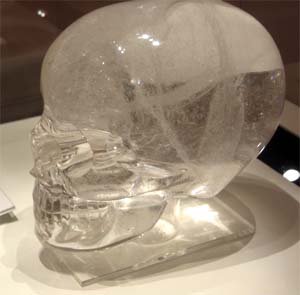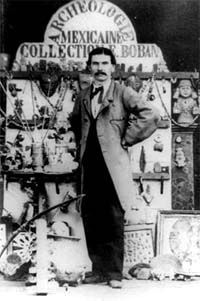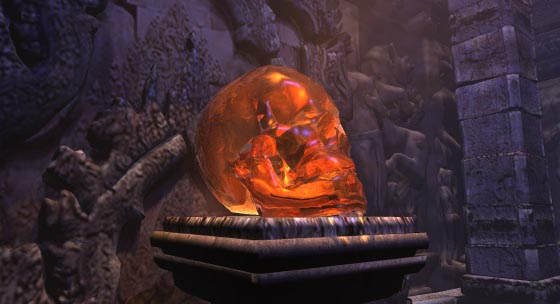The
Eerie Crystal Skulls
The movie Indiana Jones and the Kingdom of
the Crystal Skull highlights these strange archaeological
oddities. Were they created in ancient times for paranormal purposes
or are they modern fakes?
Some people with a mystical bend credit them with
strange, supernatural powers. Geologists marvel at their size.
Archaeologists wonder who made them. And nobody denies that they
possess an eerie, horrible beauty unmatched by almost any other
objects. They are the crystal skulls.
There have been many replicas of human skulls that
have been polished out of a crystal of rock. Some might be ancient,
others contemporary. A few have been made from pure quartz and
are absolutely clear, while others sport a myriad of colors. A
rare few are life-sized and carved out of a single crystal of
quartz.
Crystal
Quartz
Quartz, composed almost entirely of silicon dioxide,
is found in almost every type of rock and can form huge crystals
that weigh tons. While it is colorless and transparent when pure,
if a tiny portion of the silicon atoms are replaced with iron,
aluminum, manganese or titanium, the crystal can take on beautiful
colors. Amethyst is violet quartz. Jasper is quartz
with red, yellow, brown, gray or black coloring. Onyx and
agate are quartz with bans of color. Bloodstone
is green with red spots. If a single streak runs through the quartz
it might be called cat's eye, tiger's eye or rutile.
Skulls have been carved out of almost every variation of this
mineral.
All crystal is ancient and there are no good ways
of guessing how long ago a skull shape was carved or polished
out of the quartz. Scientists have examined some of the skulls
whose history is not known looking for tiny marks that may tell
what type of tools were used to carve them, but this may not always
give a reliable age or origin. It does not eliminate contemporary
artists using ancient methods.
The owners of crystal skulls often credit them with
paranormal powers such as divination (like a crystal ball) and
healing. While there are many skulls carved out of quartz, two
are particularly famous and controversial. Both are made of clear
crystal and are approximately life-sized: The "Mitchell-Hedges"
skull and a skull owned by the British Museum.
|

The
skull at the British Museum of Mankind was originally thought
to be of Aztec origin. (Wikiapedia Commons
Share Alike/Sayamindu)
|
The
British Museum Skull
The British Museum's skull, which stands about eight
inches high, was part of the exhibit at the Museum of Mankind
in London for many years. The skull sat in a case there labeled
as "possibly of Aztec origin- the colonial period at the earliest."
This was guesswork on the part of the museum staff, however. The
museum obtained the skull from Tiffany's, the New York jewelers.
From there the providence of the object gets a little foggy, though
there were rumors that it was part of a collection amassed by
a mysterious soldier of fortune in Mexico. Examinations of the
skull in the 1950's suggested that a rotary tool had been used
to shape the skull. Since such a device was unknown to the Aztecs,
speculation grew that instead the skull was made in Europe in
the 19th century.
Recently, Professor Ian Freestone, of the University
of Wales in Cardiff, re-examined the skull with modern high-tech
tools and came to a similar conclusion. Freestone cast the skull
with dental resin, and then put the cast through a scanning electron
microscope. Under high magnification he saw straight, perfectly-spaced
surface markings, which could be attributed to a modern polishing
wheel. Freestone also noted that the type of crystal in the skull
came from Brazil, not Mexico, which makes it unlikely to be of
Aztec origin. The sharp features in the carving, he believes,
do not fit the Aztec style either, which has a softer look.
Freestone notes that critics of his conclusion might
argue that the marks he observed came from a more recent cleaning,
not from the original carving. "Stone is one of the hardest materials
to date," he admits. "That is why it has been an open question
for so long. It's still not definitively solved and it will never
be." The professor goes on to say that even if its providence
is not ancient, the object still seems to fascinate people. "If
you see this skull in bright light it is fairly impressive, whatever
your views about its origin. Most people who have encountered
it do say it has made an impression."
Some of the staff at the Museum of Mankind
might agree. Though the skull is no longer displayed because its
origins are in question, it is so strangely hypnotic that there
is a story that the museum maintenance crew at one time insisted
that the object be covered with a black cloth before they worked
around it at night.
Mitchell-Hedges
Skull
The Mitchell-Hedges skull has an even more checkered
past than the one at the Museum of Mankind. Its supposed
discoverer, Frederick Albert Mitchell-Hedges, was a self-proclaimed
British adventurer during the early twentieth century. He traveled
through much of South and Central America and the Caribbean working
sometimes as an explorer for different organizations, at other
times as a correspondent for the Daily Mail. He contended
that he found the skull while exploring an ancient temple in the
Mayan city of Lubaantun in British Honduras. He seemed, however,
very reluctant to reveal the details, writing: "How it came into
my possession I have reason for not revealing."
Mitchell-Hedges, a colorful character if there ever
was one, was apparently not above telling a few tall tales. He
alleged that he had gambled with the rich J.P. Morgan, roomed
with Leon Trotsky and fought with Pancho Villa. All of these stories,
however, appear to be total fabrications.
The skull itself, of course, is very real, but how
it came into Mitchell-Hedges possession is an open question. We
know for sure that he owned it in 1944. That year a member of
the staff of the British Museum bid on the skull at an auction
and made this note:
Bid at Sotheby's sale, lot 54, 15 x 43 up to
340 [pounds] (Fairfax). Brought in by Burney. Sold subsequently
by Mr. Burney to Mr. Mitchell-Hedges for 400 [pounds].
Some researchers believe the story about finding
the skull in Honduras was just another tall tale and Mitchell-Hedges
obtained it through Burney (an art dealer) at the Sotheby's sale.
Other members of that Honduras expedition, Lady Richmond Brown
and Dr. Thomas Gann, never wrote or spoke about Mitchell-Hedges
finding a skull, though such an event would be of remarkable interest.
|

Not
all skulls are clear. This skull, known as the "Mayan,"
has a hazy, greenish color. (Copyright
of F.R. 'Nick' Nocerino. The Museum wishes to thank Mr.
Nocerino and the The
Society of Crystal Skulls, International for its use.)
|
Mitchell-Hedges' adopted daughter, Anna Mitchell-Hedges,
supported her father's story. Anna, who inherited the skull when
her father died, argued that her father only placed the skull
with Burney as collateral for a loan and when he realized Burney
was trying to sell the stone, he bought it back at the auction.
Anna, in fact, seems to have added to the original
version of how the skull was found. She claimed that she had gone
along on the expedition and that it was she who discovered the
skull on her 17th birthday. According to her account she found
the skull (missing the jaw) under an ancient alter. Three months
later she also found the matching jaw in the same room. Critics
doubt Anna's story, however, as there is no evidence she was along
on the expedition and none of the many photographs taken during
that trip include her.
The skull itself, probably the strangest gemstone
in the world, weighs some 11 lbs., 7 oz (5.19kg), stands 5 ¼ inches
high, and is carved out of a single quartz crystal. Mitchell-Hedges
often referred to it as the "Skull of Doom." The separate jaw
looks like it might have been wired to move, perhaps giving it
the ability to appear to be speaking. Mitchell-Hedges theorized
the skull was used as an oracle, the jaw operated by remote control
as a voice came from a hidden speaker tube. It isn't hard to picture
the priest of some ancient religion dazzling his followers with
such a display.
Though, there is much lore about the skull, most
of it seems to have come from Mitchell-Hedges imagination, instead
of actual history or scientific investigation. He once wrote:

Eugene Boban
in front of a display of his Mexican artifacts.
|
Skull of Doom is made of pure rock crystal and
according to scientists, it must have taken over 150 years, generation
after generation working all the days of their lives, patiently
rubbing down with sand an immense block of rock crystal until
finally the perfect Skull emerged. It is at least 3,600 years
old and according to legend was used by the High Priest of the
Maya when performing esoteric rites. It is said that when he willed
death with the help of the skull, death invariably followed. It
has been described as the embodiment of all evil.
The above quote is from Mitchell-Hedges book Danger
is My Ally, but it is unclear where Mitchell-Hedges got the
information. The actual history of both the Mitchell-Hedges skull
and the British skull probably has less to do with generations
of Aztec workers patiently rubbing them with sand, however, and
more to do with a Frenchman named Eugene Boban.
The
Boban Connection
Boban, a gentleman of dubious reputation, lived
in the 19th century and seems to be associated with the appearance
of both skulls as well as with a third skull now at the Musee
de l'Homme in Paris. Boban operated a business in Mexico for
some years that traded in artifacts. Apparently it was Boban that
sold the British skull to Tiffany's. Instead of obtaining the
skulls in Mexico, however, it is thought he got them from Germany
where they were carved during the 19th century. During that period
large amounts of Brazilian quartz crystal were imported and shaped
there.
There is certainly evidence that supports the idea
that both the skulls came from the same source. One scientist,
Dr. G. M. Morant, got to examine what is thought to be the Mitchell-Hedges
skull (then in Burney's hands) and the British skull together
in 1936. He noted the skulls were very similar in many anatomical
details. It was his theory that the one in the British Museum
might be a slightly rougher copy of the Mitchell-Hedges skull.
Despite their suspicions neither Morant, nor later
Freestone, has been able to definitely establish a time or place
where either of these skulls were created. So, many people continue
to attribute them with ancient origins and remarkable powers.
Even if they lack paranormal capabilities, however, they remain
fascinating oddities set in crystal stone.

Were crystal
skulls used for worship in some hidden temple?
 (Copyright
Lee Krystek, 2008). (Copyright
Lee Krystek, 2008).
|
A Partial Bibliography
Rock Crystal Skull: The British Museum Website, http://www.britishmuseum.org/explore/highlights/highlight_objects/
aoa/r/rock_crystal_skull.aspx "
Secrets of the Supernatural By Joe Nickell, Prometheus
Books, 1988.
Exhibiting Dilemmas: Issues of Representation at the Smithsonian
by Amy Henderson and Adrienne L. Kaeppler. ,Smithsonian Institution
Press, 1997.
The mystery of the British Museum's crystal skull is solved.
by Steve Connor, The London Independent, January 7, 2005.
Comments on the Morphological Comparison of Two Crystal Skulls.
By Adrian Digby, Man, Royal Anthropological Institute of Great
Britain and Ireland, July 1936.

Copyright Lee Krystek
1998-2008. All Rights Reserved.